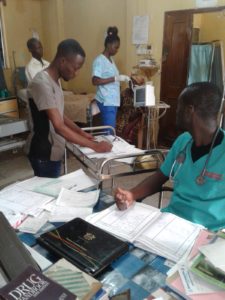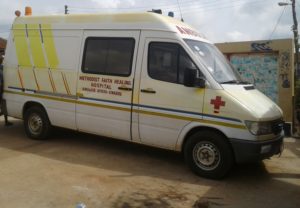
ER staff working hard
The accident and emergency unit at Ankaase is the first point of contact for those patients needing quick and targeted emergency care. It is a ten bed unit servicing adult and pediatric patients with a procedure room for minor interventions such as suturing, removal of foreign bodies, catheterization and other procedures.
The department is staffed by an Emergency Physician Specialist, Critical Care Nurse, Registered General Nurses, Enrolled Nurses, ward assistants who administer care for over 300 patients per month. The main goal of this unit is to provide quick and effective care of urgent patients and transfer them to the other units for further management after they have been stabilized.
As Ankaase is a district hospital the emergency department receives a large number of referrals from outlying health centers. Referred cases such as severe malaria, those with acute abdomen, CVA (strokes) and asthmatic emergencies in addition to renal, hypertensive and diabetic emergencies are commonly managed cases at the unit. As a district emergency unit, the management of patients is aided by devices such as cardiac monitors, nebulizers, pulse oximetry monitoring, blood glucose monitors, cervical collars, and oxygen delivery devices.
Ambulance Service
The ambulance unit is used to mainly transport referred patients who need advanced medical care. Managed by a team of specially trained nurses and drivers, the ambulance service is a unique part of the services provided at Ankaase. Only members of the ambulance team, a trained group of nurses knowledgeable in the accurate mechanisms of patient transport and monitoring, are permitted to transport referred patients.

The ambulance is equipped with oxygen and a transport stretcher and during transport patient monitoring is accomplished by using a pulse oximeter and other items found in an emergency resource bag. In ensuring a family-centered approach to patient care, a family member is permitted to join the referred patient in the ambulance during transport as this can help reduce the anxiety of the patient in addition to promoting a safe and healthy commuting environment.
